Live videos by brands were quite popular even before the pandemic. However, Covid-19 has made this content extremely sought-after both for businesses and consumers. Online interactions became the only means of communication between people literally overnight. In turn, streams became the workaround that allows companies not to lose the sense of a real connection with the audience. Moreover, live videos turned out to be an extremely effective marketing tool: engaging and convenient in terms of shopping.
After all, now live streaming is as affordable and easy as ever before. Every single social media platform has the corresponding functionality. It costs you nothing to start a stream and your followers receive push notifications every time you go live. Why not try it out sometime?
Further, we’ll explore some stats, underline the reasons for live streaming, consider types of live content that you can apply to your social media content plan, and discuss particular examples.
Why Can Going Live Be Profitable?
In the ever-increasing competition, it takes more and more effort for businesses to promote products/services and obtain loyal customers. Such things as fast, user, and mobile-friendly websites are not a luxury but a necessity nowadays (for instance, see some impressive progressive web apps examples).
But this is not enough. People expect brands to be more personalized, mindful, and interactive. They want to see humans behind labels. This is where live streaming steps in.
Experts outline several positive effects that brands can reach by utilizing live broadcasting:
- Efficient engagement. Live videos allow to interact with consumers directly and in real-time by answering questions, getting feedback, and seeing instant reactions on products/content/presenters.
- Brand humanization. Live videos help to bring a company closer to viewers since it implies a great deal of extemporaneous communication and actions. This content is not polished, it looks natural, and gives the behind-the-scenes experience which attracts people.
- Entertainment and education. Streams have a vast potential to give wholesome knowledge and pleasant emotions simultaneously.
- The sense of presence. Unlike pre-recorded videos, live videos bring the feel of being at an offline event that is especially valuable amid the pandemic. Furthermore, by broadcasting something exclusive like a new collection drop, you can widen the audience. More people will feel like they are participating in a special event.
- Increasing brand awareness and loyalty. Diverse content engages more people. Meaningful content makes your customers respect your brand as they see not only salespeople but also value bearers who are happy to share knowledge and skills, bring avail and joy. Eventually, such a marketing strategy leads to sales growth.
Some Curious Stats to Consider
Videos, on the whole, became an integral part of marketing strategies across industries long ago. Let’s see how consumers perceive live videos (from brands and in general) and what it means for businesses.
- People watch live videos 10 to 20 times longer than pre-recorded content.
- Live streaming is an absolute blast in China, with 425-million people making up the audience in 2018 alone.
- About 80% of consumers prefer to watch a brand’s live videos rather than read its blog and/or posts on social media.
- 67% percent of live broadcast viewers later purchased tickets to similar events (gigs, conferences, webinars, and so on).
- About 35% of marketers leverage live streams in their social media strategy.
Which Formats to Choose?
There are several proven genres for live streaming that your company can try. Let’s observe the four most popular of them: virtual events, tutorials, product presentations, and work with influencers.
1. Online Events
There is a large room for maneuver since every topic related to the brand’s specialization and values can be a subject of the stream. Mango is a vivid example here. In the screenshots below, you’ll see how creatively the brand builds its live streaming strategy on Instagram.
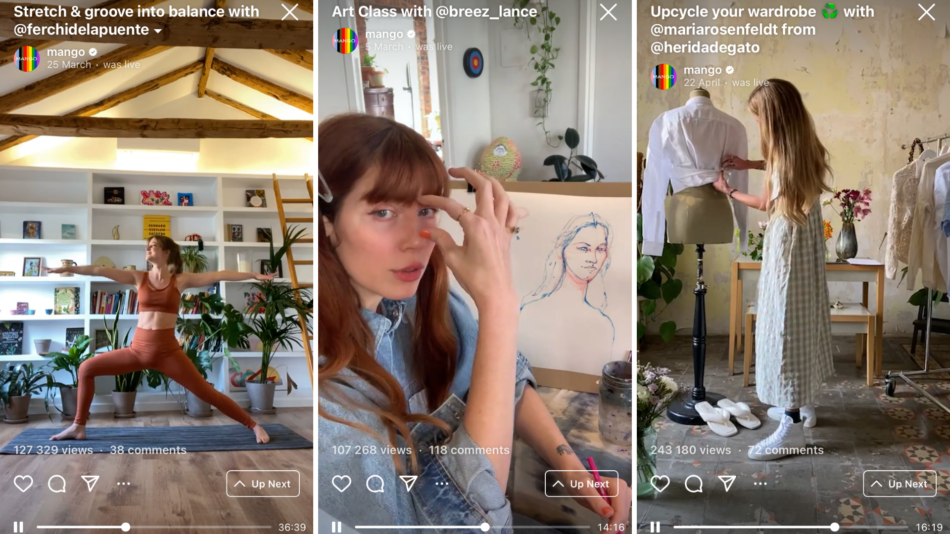
Screenshot taken from the official Mango Instagram account
Professionals from different areas conduct:
- yoga, ballet, and stretching classes;
- art and cooking classes;
- musical and meditation sessions;
- show how to reuse old garments and customize them.
This circle of topics reflects what the brand is all about: conscious consumption, creation, freedom, talent, and health. Every live video lasts for 40-50 minutes on average and, basically, collects plenty of views, likes, and comments.
Note that Mango doesn’t advertise goods in such videos, although the medium gives an opportunity to do so (we’ll discuss this later on). These streams aid in winning a loyal audience that sees similar values and, thus, chooses exactly this brand. Therefore, not only Stories and Reels matter.
2. Product Presentations
YouTube is traditionally occupied by hi-tech brands that stream their launches of new collections fairly frequently. There are electronics giants (Apple, ASUS, Xiaomi, and so on) and car manufacturers.
For instance, Tesla recently went live to demonstrate a new Model S Plaid. This spectacular video made viewers feel like they participated in a huge occasion.
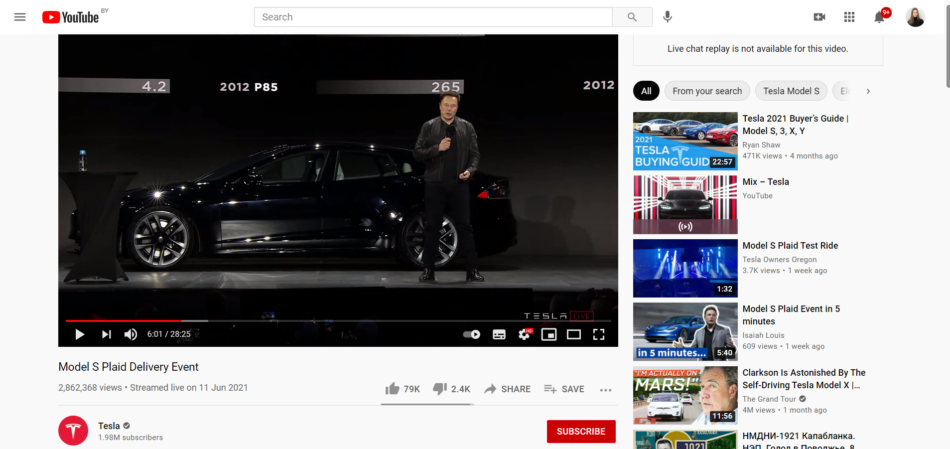
Screenshot taken from the official Tesla YouTube channel
Another interesting example is IKEA, which also experiments with live streams. A couple of weeks ago, it showed a live event dedicated to launching a new series of speakers. Such positioning grabs the audience’s attention and makes products even more attractive to people.
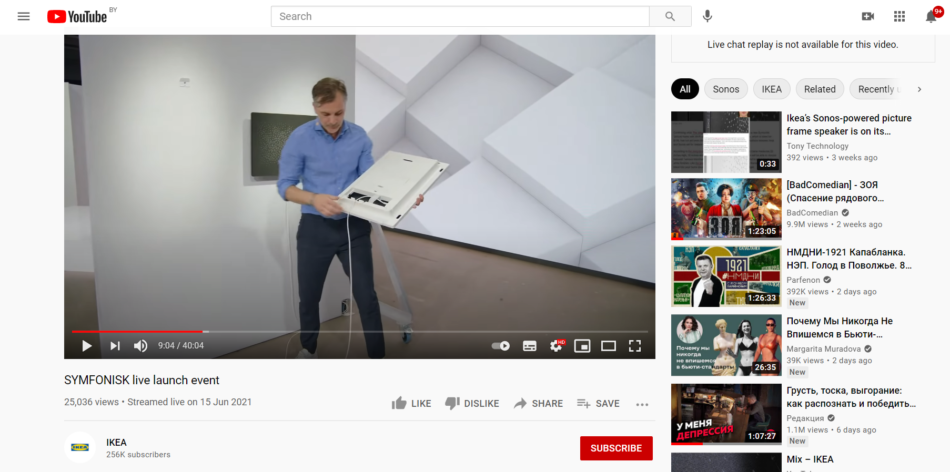
Screenshot taken from the official IKEA YouTube channel
3. Collaborations
Influencers can not only make your live content more fascinating but also bring their followers to your account that expands brand awareness.
For instance, NARS quite often invites beauty bloggers for makeup tutorials with new product testing. Two in one: you promote the commodities and provide added value to your audience.
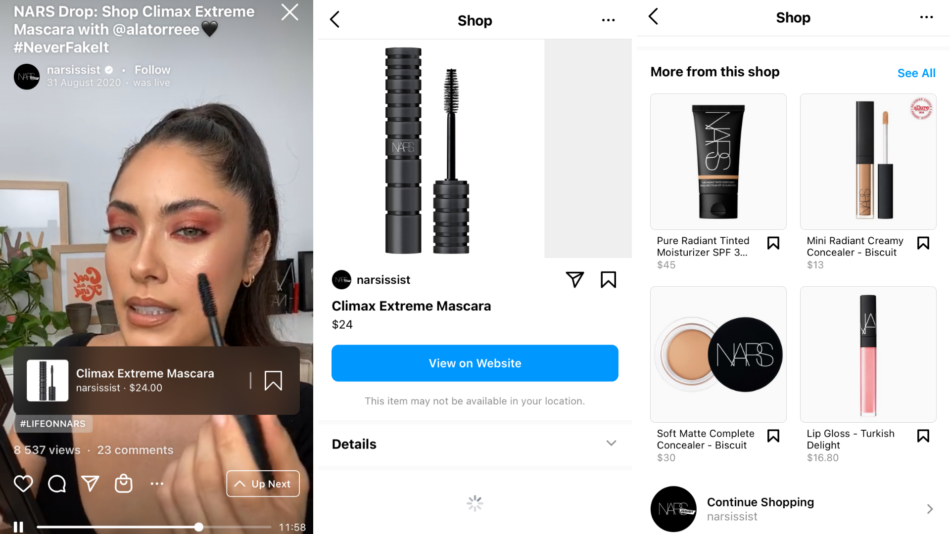
Screenshot taken from the official NARS Instagram account
As you see, there are shoppable tags in the video. You can learn more about the item and go to the website to buy it. For some products like eyeshadow, there is even a built-in virtual try-on to choose the right hue.
4. Tutorials
Finally, various “How-To” live videos are highly actionable as long as your customers and prospects can find them helpful for their everyday life. Again, don’t limit yourself with your proximate direction.
For example, Molbak’s Garden + Home uses Facebook Live to share knowledge and ideas, tips and tricks on gardening, home décor, and so forth. Usually, their videos are dedicated to plant varieties, treating, and fertilizing. But besides this, staff members make home décor and cook.
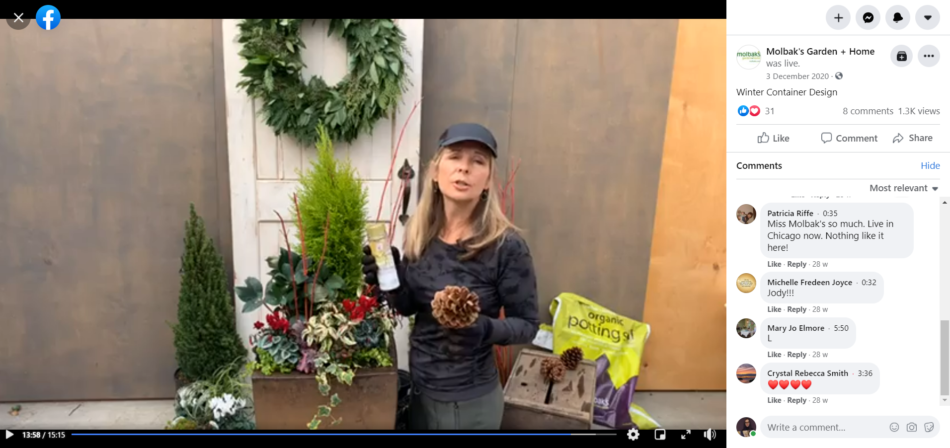
Screenshot taken from the official Molbak’s Garden + Home Facebook account
Basically, streams last for 10-20 minutes. People can ask questions and get answers immediately. The host sees comments and can address them right during the live. It’s extremely handy both for viewers and the staff since there’s no need to track comments and answer them later.
Ecommerce Live Streaming
China went further: so-called live streaming eCommerce is growing by leaps and bounds there. This concept implies product promotion, testing, entertaining, and selling during live streams.
Basically, such live events are hosted by bloggers on particular platforms. The most prominent of them is Taobao Live which was launched in 2016 by Alibaba Group. As of now, about 80% of streams are conducted via this means. But there are a few more on the Chinese market.
Taobao Live is a hybrid thing: partly an eCommerce marketplace, partly social media. The thing is that you can purchase right during the stream without even leaving the app. Your bank account has already been linked to the platform. Customer support and other core services are also a part of Taobao Live. The shopping looks like this (see the screenshot below):
- As you view the video, hosts demonstrate, test, and comment on different products. Then the link to a particular featured item appears on your screen. Often there are appealing discounts/coupons offered to fuel sales.
- You can click the link and see the details about the product. If you want, you buy it right here and now. In the meantime, the video will still be here on a little additional screen above the product page. You don’t leave the platform to place an order.
- You may return to the stream instantly and wait for another tempting offer. Live eCommerce streams last for about 4 hours every day. During them, anchors answer questions, entertain the audience: sing or interview guests.
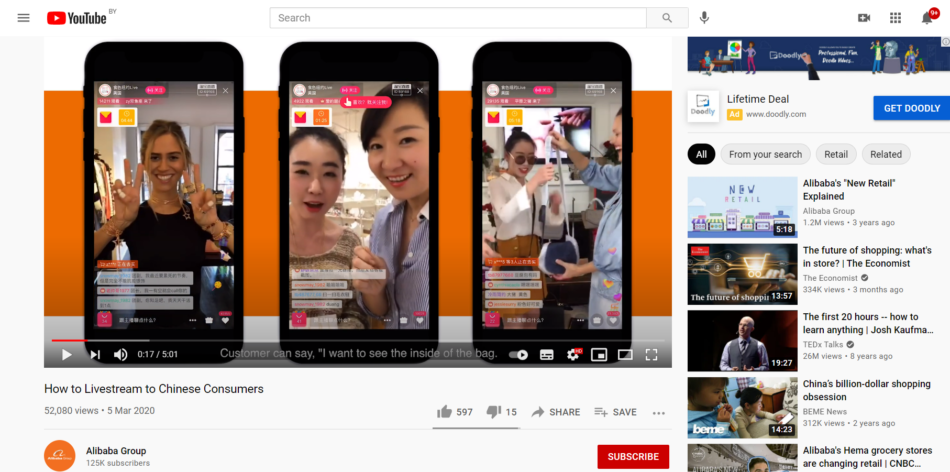
Screenshot taken from the official Alibaba Group YouTube channel
It turned out to be a lucrative format for China: 30% of the population viewed live streams, and 37% of online shoppers bought something during streams in 2019.
Experts predict that live streaming in eCommerce fairly shortly can come to the U.S. and then steadily spread worldwide. The presentation style is expected to be drastically different from the Chinese one, but the concept itself is likely to be adopted in due course.
Final Word
Marketers all over the world seek effective forms of interaction with current and future customers. The live broadcasting functionality on social media has significantly broadened our toolkits. Certainly, leveraging live videos requires much time and creativity as well as some flexibility and trust from the decision-makers in your company. But I think it’s a worthwhile undertaking.
Streaming makes your brand-friendly and transparent to customers. Lives entertain and educate, therefore, create emotional links with people. Such videos help to stand out on the market and outperform lazier competitors. Hence, streams will auspiciously influence sales.







